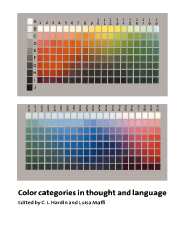Book contents
- Frontmatter
- Contents
- Notes on contributors
- 1 Introduction
- I THE WORLD COLOR SURVEY
- II VISUAL PSYCHOLOGISTS
- III ANTHROPOLOGISTS AND LINGUISTS
- IV DISSENTING VOICES
- 14 It's not really red, green, yellow, blue: an inquiry into perceptual color space
- 15 The linguistics of “color”
- 16 Closing thoughts
- Subject index
- Author index
14 - It's not really red, green, yellow, blue: an inquiry into perceptual color space
Published online by Cambridge University Press: 20 August 2009
- Frontmatter
- Contents
- Notes on contributors
- 1 Introduction
- I THE WORLD COLOR SURVEY
- II VISUAL PSYCHOLOGISTS
- III ANTHROPOLOGISTS AND LINGUISTS
- IV DISSENTING VOICES
- 14 It's not really red, green, yellow, blue: an inquiry into perceptual color space
- 15 The linguistics of “color”
- 16 Closing thoughts
- Subject index
- Author index
Summary
This chapter presents two arguments. The first argument is that, contra Hering, Hurvich and Jameson, De Valois, and others, the fundamental chromatic axes of the opponent processes are not red/green and yellow/blue. The second argument is that the results found by Berlin and Kay, Rosch, and others, which indicate that particular regions of the color space are selected as the natural locations for color terms, are not due to opponent processes, but to irregularities in perceptual color space. In general, we suggest that alternative theories should be sought as the bases for cognitive models of subjective color experience. To do this we present an overview of commonly used color spaces and scalings of these spaces; we discuss opponent-colors theory and related neurophysiology, and point to some problems with the theory; we examine some empirical phenomena (e.g. additive complements, negative afterimages, etc.) and the possible relation of these phenomena to the organization of color space; we consider unitary hues as relating to color space cardinal axes; and propose a plausible alternative model and discuss its relevance to research in anthropology and psychology.
In the literature addressing the psychological and physiological character of human color vision there is a general account that goes as follows.
(1) Color is organized perceptually in a three-dimensional space as presented in Figure 14.1 below, with red/green (R/G) and yellow/blue (Y/B) as cardinal axes of the space, plus light/dark (white/black for surface colors) as the third dimension.
- Type
- Chapter
- Information
- Color Categories in Thought and Language , pp. 295 - 319Publisher: Cambridge University PressPrint publication year: 1997
- 99
- Cited by



